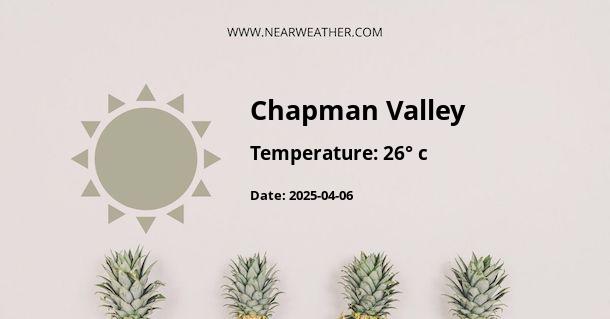Chapman Valley, Australia: Climate and Weather Overview
Chapman Valley is a picturesque region located in the Midwest of Western Australia. The climate in Chapman Valley is characterized by its Mediterranean climate, typically experiencing hot, dry summers and mild, wet winters. Understanding the year-round weather patterns is essential for residents, tourists, and agricultural practices. Let's delve into the detailed climate and weather conditions in Chapman Valley throughout the year.
Chapman Valley Climate Data
The following table provides a comprehensive overview of the average climatic conditions in Chapman Valley:
| Month | Temperature (°C) | Precipitation (mm) |
|---|---|---|
| January | 25-35°C | 10-20mm |
| February | 25-35°C | 5-15mm |
| March | 23-33°C | 10-20mm |
| April | 19-28°C | 20-30mm |
| May | 15-23°C | 50-60mm |
| June | 13-20°C | 80-90mm |
| July | 12-19°C | 90-100mm |
| August | 13-20°C | 70-80mm |
| September | 15-23°C | 40-50mm |
| October | 18-27°C | 20-30mm |
| November | 21-30°C | 10-20mm |
| December | 24-33°C | 5-15mm |
Seasonal Weather Patterns
The climate in Chapman Valley is marked by distinct seasonal variations:
- Summer (December - February): Summers in Chapman Valley are hot and dry, with temperatures frequently reaching 35°C. The region experiences minimal precipitation during this period.
- Autumn (March - May): Autumn brings milder temperatures, ranging from 19-33°C, and moderate rainfall, making it an ideal time for outdoor activities and agricultural pursuits.
- Winter (June - August): Winters are characterized by cool temperatures, averaging between 12-20°C, and higher levels of rainfall, providing essential moisture for the surrounding landscape and agricultural activities.
- Spring (September - November): Spring in Chapman Valley sees a gradual increase in temperatures, ranging from 18-30°C, and a decrease in precipitation, marking the onset of the dry season.
Extreme Weather Events
Chapman Valley, like many regions in Australia, is susceptible to extreme weather events, including heatwaves and occasional bushfires during the hot, dry summers. These events are closely monitored by local authorities to ensure the safety of residents and visitors.
Agricultural Impact
The climate and weather patterns play a crucial role in shaping the agricultural landscape of Chapman Valley. The region's Mediterranean climate supports the cultivation of a diverse range of crops, including wheat, canola, and lupins. The winter rainfall is particularly beneficial for crop growth, while the dry summers necessitate efficient water management practices.
Conclusion
In conclusion, Chapman Valley's Mediterranean climate brings distinct seasonal variations, from hot, dry summers to mild, wet winters. Understanding the climate and weather patterns is vital for residents, farmers, and visitors alike, shaping agricultural practices and outdoor activities throughout the year.
A - Chapman Valley's Latitude is -28.272490 & Longitude is 115.027939.
A - Weather in Chapman Valley is 26° today.
A - Climate Conditions in Chapman Valley shows clear sky today.
A - Humidity in Chapman Valley is 48% today.
A - Wind speed in Chapman Valley is 14.08 km/h, flowing at 356° wind direction. today.
